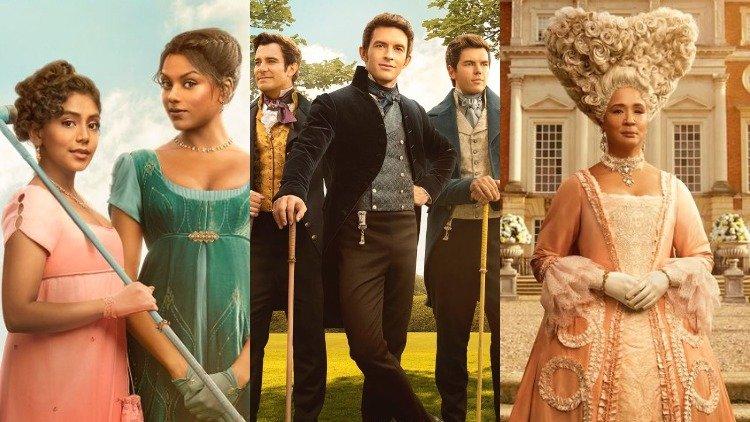𝗪𝗵𝗮𝘁 𝘀𝗼𝗿𝘁 𝗼𝗳 𝗽𝗿𝗲𝘀𝗲𝗻𝘁𝗮𝘁𝗶𝗼𝗻 𝗮𝘄𝗮𝗶𝘁𝘀 𝘂𝘀 𝗶𝗻 𝗕𝗿𝗶𝗱𝗴𝗲𝗿𝘁𝗼𝗻 𝗦𝗲𝗮𝘀𝗼𝗻 𝟮?
It was within the middle of the pandemic when Bridgeton's first season hit our screens, barrelling the whole world into a frenzy over a surprisingly articulate romantic period drama. However, where Bridgerton seized the essence of the Regency era romance with its pastel themes and elegant gowns, it also subverted expectations by employing a non-traditional casting practice.
It introduced Regé-Jean Page because the Duke of Hastings, an individual of color, together with the most leads, to not mention the introduction of Queen Charlotte and Marina Thompson as significant foils to Bridgerton's otherwise all-white cast. People believed within the concept Bridgerton, despite its abundance of tropes and themes befitting a historical drama, is additionally willing to explore race among its many themes.
In this upcoming season, Bridgerton will dig its storytelling claws into an Indian family, the Sharmas. It is notable how Kate Sheffield, from The Viscount Who Loved Me, the book the upcoming Bridgerton season is predicated on, became Kate Sharma for the difference. Marina Thompson and therefore the Duke are being replaced with the Sharma family, it's uncertain whether these new characters are going to be treated with more dignity than what was given to the Duke and Marina.
It isn't enough to only introduce a couple of history-defying characters if they are not given the required dignity to their respective struggles. It needs to be understood that the representation can never be successful without adhering to its many storytelling responsibilities.
So, would Kate be an all-encompassing character with an upscale culture and heritage of her own, or would her heritage be consequently dismissed with a couple of identifying remarks and poor covers of Bollywood music?
#studentjournalist
It was within the middle of the pandemic when Bridgeton's first season hit our screens, barrelling the whole world into a frenzy over a surprisingly articulate romantic period drama. However, where Bridgerton seized the essence of the Regency era romance with its pastel themes and elegant gowns, it also subverted expectations by employing a non-traditional casting practice.
It introduced Regé-Jean Page because the Duke of Hastings, an individual of color, together with the most leads, to not mention the introduction of Queen Charlotte and Marina Thompson as significant foils to Bridgerton's otherwise all-white cast. People believed within the concept Bridgerton, despite its abundance of tropes and themes befitting a historical drama, is additionally willing to explore race among its many themes.
In this upcoming season, Bridgerton will dig its storytelling claws into an Indian family, the Sharmas. It is notable how Kate Sheffield, from The Viscount Who Loved Me, the book the upcoming Bridgerton season is predicated on, became Kate Sharma for the difference. Marina Thompson and therefore the Duke are being replaced with the Sharma family, it's uncertain whether these new characters are going to be treated with more dignity than what was given to the Duke and Marina.
It isn't enough to only introduce a couple of history-defying characters if they are not given the required dignity to their respective struggles. It needs to be understood that the representation can never be successful without adhering to its many storytelling responsibilities.
So, would Kate be an all-encompassing character with an upscale culture and heritage of her own, or would her heritage be consequently dismissed with a couple of identifying remarks and poor covers of Bollywood music?
#studentjournalist
𝗪𝗵𝗮𝘁 𝘀𝗼𝗿𝘁 𝗼𝗳 𝗽𝗿𝗲𝘀𝗲𝗻𝘁𝗮𝘁𝗶𝗼𝗻 𝗮𝘄𝗮𝗶𝘁𝘀 𝘂𝘀 𝗶𝗻 𝗕𝗿𝗶𝗱𝗴𝗲𝗿𝘁𝗼𝗻 𝗦𝗲𝗮𝘀𝗼𝗻 𝟮?
It was within the middle of the pandemic when Bridgeton's first season hit our screens, barrelling the whole world into a frenzy over a surprisingly articulate romantic period drama. However, where Bridgerton seized the essence of the Regency era romance with its pastel themes and elegant gowns, it also subverted expectations by employing a non-traditional casting practice.
It introduced Regé-Jean Page because the Duke of Hastings, an individual of color, together with the most leads, to not mention the introduction of Queen Charlotte and Marina Thompson as significant foils to Bridgerton's otherwise all-white cast. People believed within the concept Bridgerton, despite its abundance of tropes and themes befitting a historical drama, is additionally willing to explore race among its many themes.
In this upcoming season, Bridgerton will dig its storytelling claws into an Indian family, the Sharmas. It is notable how Kate Sheffield, from The Viscount Who Loved Me, the book the upcoming Bridgerton season is predicated on, became Kate Sharma for the difference. Marina Thompson and therefore the Duke are being replaced with the Sharma family, it's uncertain whether these new characters are going to be treated with more dignity than what was given to the Duke and Marina.
It isn't enough to only introduce a couple of history-defying characters if they are not given the required dignity to their respective struggles. It needs to be understood that the representation can never be successful without adhering to its many storytelling responsibilities.
So, would Kate be an all-encompassing character with an upscale culture and heritage of her own, or would her heritage be consequently dismissed with a couple of identifying remarks and poor covers of Bollywood music?
#studentjournalist







